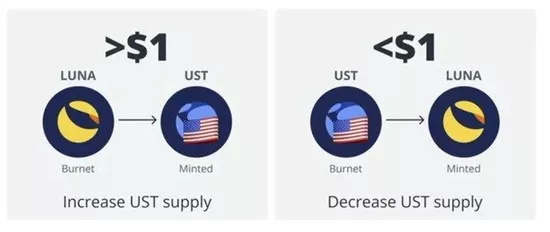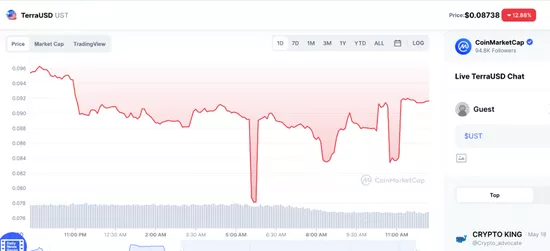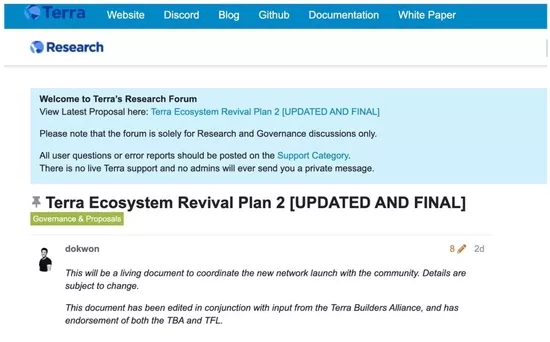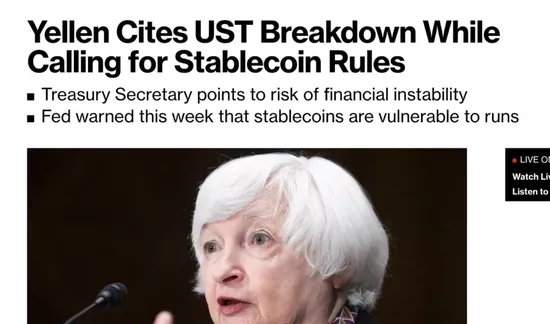Not surprisingly, the coin circle exploded again. Whether you are concerned about digital currency or Web3, I believe you have heard of the recent collapse of Luna A digital currency with a market value of US $41 billion and sought after by hundreds of thousands of people overseas suddenly plunged without warning. In just a few days, the price fell from nearly US $90 to less than US $0.00015
Epic "return to zero", carefully planned hunting, revival plan and aftershocks in the coin circle.
Text | Juny editor | vickyxiao
Tens of billions of assets were wiped out in an instant, and those who continued to increase their positions on the way of the crash ended up losing all their money.
Such a tragic crash can be said to be very rare in the whole financial market. Since then, Luna not only triggered the currency circle earthquake with her own strength, creating a spectacular scene in which hundreds of coins fell together, but also broke the circle and rushed to the front page of hot search in various countries, which attracted extensive attention.

As of May 19, Luna's price, the picture is cut from coinmarketcap
Now, more than a week has passed since Luna plummeted, but it's not over yet. Recently, the truth of this stable currency full of the meaning of "Ponzi scheme" has been revealed bit by bit, the process of the organization "hunting" Luna has gradually become clear, and a series of subsequent chain reactions have begun to appear.
In this article, silicon star people will take you to comprehensively resume the Luna crash. Let's take a look at how the digital currency experiment, which was carried out by foreign leeks at a cost of $40 billion, started, went to the altar and collapsed suddenly.
A well-designed white whoring game, which uses algorithms to create speculators' "dream of getting rich"
Although many people have seen the news of Luna's sharp decline, most people only know about Luna as a digital currency and lament the high risk of digital currency, but they only know a little about what Luna is and its value operation mechanism.
In fact, to understand Luna, you need to find out what is the so-called algorithmic stability coin and the terra ecology in which Luna exists.
The algorithm of "pedal air" is stable
For ordinary people, "collapse again" may be the three most commonly heard words about digital currency. In the face of this often violent fluctuation, some people began to think, can there be a digital currency that can not only easily convert transactions in the digital world, but also avoid fluctuations?
So the idea of a stable currency was born. In 2014, tether company under bifinex, a digital currency exchange, issued the world's first stable currency usdt, which is 1:1 linked to the US dollar. It means that every time you issue a usdt, you must deposit a dollar in your bank. In addition to usdt, the stable currency usdc issued by coinbase and circle in 2018 also exists in this way.
However, with the development of time, many people began to think that such a 1:1 mortgage model is too old-fashioned and not Web3. Can we keep the price of digital currency stable without spending dollars and relying on central institutions?
Then, the thinking coin circle came up with two new ways to play, and two stable coins that sounded unstable were born.
One is to replace the mortgaged assets from US dollars with mainstream cryptocurrencies such as bitcoin and Ethereum. Since these cryptocurrencies are much more risky than US dollars, more mortgages are set as a guarantee. Another more advanced way to play is simply not to mortgage any assets, and completely rely on algorithms to adjust the relationship between supply and demand, so as to create and maintain monetary value.
The latter is called algorithmic stability currency, which has no real asset support behind it. Previously, the largest and most mainstream algorithmic stable currency system in the market was Terra where Luna was located.

The types and characteristics of stable coins are made by silicon star people. The copyright belongs to silicon star people
Play "white wolf with empty hands" to the flying Terra
The logic of algorithmic stable currency sounds very unscientific. How can a digital currency have stable value out of thin air? The answer is very simple. If you have enough tricks and can fool people to pick up the plate, it will be valuable.
Around 2018, do Kwon, a Korean who graduated from Stanford University majoring in computer, established a public chain ecological Terra around the stable currency, and issued a variety of stable currencies anchored to legal tender on this chain, including ust anchored to the US dollar and KRT anchored to the Korean won, among which ust is the largest. Most importantly, he designed a mechanism similar to a seesaw to maintain the price of these stable currencies.
The two ends of this seesaw involve two subjects: Luna, an ecological token of Terra, and a stable coin (represented by UST) existing on Terra's chain. So, how to play the game?
The game has several rules: 1 A ust = Luna worth $1. It means that if Luna's price is $1, you can change a UST. If Luna's price rises to $100, you can change 100 UST. 2. Ust and Luna are "two-way destruction casting". It means that when you exchange Luna for UST, there will be one dollar less Luna and one ust more in the market. When you exchange ust for Luna, there will be one ust less in the market. Supply increases, prices fall, supply decreases, prices rise. 3. Ust is all forged by Luna, and Luna plans to issue up to 1 billion coins.
In this process, how can supply and demand remain stable? Because of the small fluctuation of ust price, there is room for arbitrage in this mechanism.
As mentioned earlier, one dollar Luna is constant equal to one UST. So when the UST is higher than $1 (such as $1.1), naturally someone will destroy their Luna for UST. In this situation, you lose $1 Luna for UST, but if each ust is higher than $1, you earn $0.1. On the contrary, when ust is less than US $1 (such as US $0.9), someone will exchange ust for Luna of US $1, so as to make a profit of US $0.1.
Some people sell at a high point and buy at a low point, which basically maintains the stability of ust price. This mechanism of stabilizing value through supply and demand is actually similar to the path of countries to maintain the stability of money value by adjusting money supply. Therefore, from the perspective of principle, the mode of "algorithm stability" seems to be OK.

The relationship between Luna and ust is from cointegraph
But after thinking about it, you will find that there is a huge bug behind this - there is a premise for this model to run, that is, Luna must be valuable, no matter how low the price is, but it can't be zero, otherwise no matter how many Lunas you send, it won't affect the price fluctuation of UST.
But Luna and ust have no value support behind them. They are completely built on the air and created out of thin air. What should we do? Therefore, we need to make leeks willing to buy, sell or hold ust and Luna, so as to give them value. Next, Terra's operation with some meaning of "Ponzi scheme" appeared.
Terra project has set up a project called anchor, which you can understand as a bank providing ust deposit and loan business. This kind of things similar to banks are actually available in other chains. The only difference is that anchor gives an annualized rate of return of up to 20% on fixed deposits.
As soon as you listen, God, in the current market environment, there can still be 20% capital guaranteed investment. Isn't this a gift from God? So many people want to own ust and deposit it into anchor to earn interest. How can we buy ust? Naturally, everyone turned their attention to Luna, which can cast UST.
In addition, Terra has also designed a series of other measures to encourage users to hold ust and improve Luna's liquidity, such as vigorously expanding the use scenario and scope of UST. As long as users mortgage Luna or Ethereum, they can borrow ust at low or even negative interest rates.
After one pass operation, the result is that more and more people want to hold UST ➡ More and more people buy Luna to cast UST ➡ Luna is in short supply ➡ The price of Luna soared.
At the beginning of 2021, the price of a Luna was less than US $1. By April this year, the price of a Luna had risen to nearly US $120, and the market value of Luna once exceeded US $43 billion. For a time, Luna became famous in the circle, investors flocked in, and ust became the third largest stable currency after usdt and usdc.
When people began to trade Luna and ust in large quantities in US dollars, the two currencies with their feet on the air began to have real value support. In the past few months, Luna's foundation LFG has successively bought $1.5 billion worth of bitcoin and several other cryptocurrencies as reserves to alleviate people's concerns about ust decoupling.
Yes, to put it bluntly, Terra has established a mechanism to collect a large amount of real money from the market empty handed, and then use the money to buy assets as their own mortgage endorsement, and then make herself look more and more credible. This is an operation made out of nothing. Who didn't say a word?

Do Kwon, founder of Terra, modified by silicon star people according to online pictures
$40 billion returned to zero in three days, and a premeditated Luna sniper battle began
Until the collapse of this month, even in the case of the double collapse of the stock market and currency circle, Luna was still in a state of rapid progress, constantly refreshing the price record. Of course, this abnormal contrarian surge has also attracted the attention of some short institutions.
As mentioned earlier, one of the most important tempting factors for us to buy a large amount of ust is the 20% deposit interest rate given by anchor. Therefore, in fact, a large number of ust (more than 70% according to legend) lie on the interest rate of anchor and are not circulating. It is the continuous burning Luna that injects liquidity into UST, so as to maintain the stability of ust price.
But the problem behind this is that once everyone starts to suddenly sell the previously lying down ust in exchange for Luna, it will lead to the disconnection of ust price, and the sharp increase of Luna supply in the market will lead to the decline of Luna price. When Luna's price continued to fall and its market value was close to or less than UST, everyone began to panic and sell ust in large quantities. At this time, the death spiral will begin, and the consequence is that Luna and ust all fall into the abyss.
In fact, this risk has always existed, but previously, when the market funds were sufficient, it was not a big problem for everyone to put their ust firmly in anchor. But some people also realize that the thunder of anchor will explode sooner or later.
How did anchor get the guaranteed 20% return? In fact, it is similar to the logic of banks in reality: the interest paid by the lender + investment income, and the investment income comes from the collateral Luna and Ethereum. However, in order to attract loans, Terra has adopted various incentives to keep the loan interest rate very low, so this part of the income is very small. In addition, in the case of poor secondary market this year, the return on collateral investment is far from reaching 20%.
What if you can't reach the 20% interest promised before? Use the reserve fund in the foundation to make up for it. From last year to this year, Terra has made up the reserve fund for many times. In February this year, founder do Kwon launched a vote again and injected $300 million into the reserve fund.

Picture from twitter
But the problem is that the reserve is also running out. According to calculation, anchor reserve is expected to be completely exhausted in June, and it is imperative to reduce deposit income at that time. Imagine that when the deposit interest rate of a financial product suddenly drops from 20% to 5%, will you still want to save your money there? Naturally, I want to take out the money and exchange it for other more stable assets. When a small number of people take the lead in doing so and cause signs of instability in ust prices, panic will begin.
After understanding this logic, a large net hunting Terra was spread out. According to the disclosure, some large institutions have successively held a large number of ust in anchor in recent months, waiting for an appropriate time to sell a large number of UST. Soon, Luna's "blood week" came.
On May 8, Terra withdrew 150 million ust from the capital pool due to the new plan, resulting in a temporary decline in ust liquidity. At this time, large institutions began a large-scale ust selling plan, resulting in the outflow of US $2 billion of ust from anchor on that day. As a result, a large number of ust suddenly appeared in the market, and the balance between supply and demand was broken, resulting in the price of ust beginning to break away from the US dollar. Many people replaced the ust in their hands with Luna, which also led to the increase of Luna's supply and the price falling from US $90 to US $60.
On May 9, Terra announced that it would use the reserve bitcoin loan of US $750 million to help stabilize UST, but the selling tide still did not end. The disconnection of ust worsened and fell below US $0.98. Many users began to panic and replaced the ust in their hands with Luna, causing the price of Luna to fall by more than 50% and the death spiral began.
On 10 may, the situation deteriorated further. Nearly US $6 billion fled from anchor, Luna's price plummeted by more than 90% to US $10, and ust completely broke off its anchor and fell to US $0.6. But at the same time, a large number of people began to copy the bottom, Luna.
On May 11, do Kwon announced that it could not save the market and could only rely on the arbitrage mechanism to help ust recover the price. Luna fell by more than 90% and the price fell below US $1. Ust once plummeted to US $0.3.
On May 12, Luna continued to plummet by 99%, almost to zero, and the UST price fell below US $0.2.
On May 13, many exchanges removed Luna and suspended trading, and Terra's public chain stopped.
On May 14, do Kwon tweeted that he did not sell any Luna. The team is sorting out the reserves and use, and preparing new proposals to help Luna rebuild. Luna soared more than 1000 times from about $0.00004.
However, Luna's price fell back quickly after a few days of "dead cat jump". At present, it hovers around us $0.00014, while the stable currency ust fell to less than US $0.09.

At present, no one has come forward to claim who is behind the planning of this incident. Previously, there were rumors that the leaders were Blackstone investment group and citadel, but recently both institutions denied it. There are also conspiracy theories that speculate from Terra's failure to actively rescue the market that it may also be internal manipulation, because they know anchor's vulnerability better than anyone else. As for the truth, interested partners can study it in depth by themselves.
︱ struggling Terra and terrified coin circle
Anyway, judging from the transaction price, ust and Luna have basically been declared "dead".
On Monday, Luna foundation guard issued a document saying that almost all bitcoins in the reserve assets were exhausted last week to try to keep ust stable, but it still failed. Today, there are only 313 bitcoins and nearly 40000 coins left in the valuable assets in the account, which they will use to compensate users.
But at the same time, founder do Kwon is also brewing terra2 Version 0 of the revival plan. In a recent event, do Kwon admitted that the UST stabilization coin project had failed, but Terra ecosystem and its community could be saved again. The plan he proposed now includes several parts:
Ø new blockchain: the existing Terra blockchain will be split into new and old chains. The new chain will be called Terra (LUNA) and the old blockchain will be called Terra classic (lunc). The difference is that the new chain has no UST.
Ø token reset: the revival plan includes a clause that stipulates that the total number of new Luna tokens in active circulation will be reset to 1 billion, and defines the distribution mechanism of these 1 billion tokens.
Ø community based cryptocurrency: TFL's wallet address will be removed from the airdrop whitelist, making Terra a fully community owned chain.
Ø new inflation rate: stimulate network security through token inflation, with a target pledge return of 7% per year.

Terra2. 0 recovery plan, intercepted from the official website of Terra project
According to the plan, the new network will be officially launched on May 27. However, a large number of netizens do not buy this. They believe that the whole significance of Terra ecosystem is to build an algorithm stable currency network. Now there is no UST, and naturally Luna has no significance. Therefore, the project should be completely closed.
For do Kwon, it may not be an opportunity to start terra2 immediately 0, there are still many thorny problems to be solved in reality. According to South Korean media reports, South Korea has launched an investigation into terra. RKB, a South Korean law firm, will sue do Kwon on behalf of investors and submit a temporary attachment order on his property. Do Kwon's wife has also applied for emergency personal safety protection, and a large number of investors are on the way to collect debts.
Terra's collapse has also worsened the currency circle, which is already in a downward bear market. Last week, just after Luna plummeted, the investment confidence of the whole digital money market suffered a heavy setback, and the currency circle followed the collective blood avalanche. And the aftermath of this event is not only that.
First, the algorithm stabilizes the currency and ushers in the "darkest moment". As the largest and most mainstream algorithmic stable currency system in the market, Terra's 40 billion market value "zeroing" process can be said to give everyone a vivid lesson and let everyone intuitively feel the power of a "death spiral". It can be predicted that for a long time in the future, if the algorithm is stable and there is no revolutionary change in the mode of currency, it will be in an extremely marginal position.
In addition, the financial risks exposed by Luna will also stimulate the tightening of regulatory policies again, which may hit the whole digital money market.
For example, US Treasury Secretary Janet Yellen said after this incident that Terra's collapse once again reflected the risk of stabilizing currency, and said that it was necessary to further strengthen the supervision of stabilizing currency and legislate as soon as possible; Klaas knot, chairman of the US financial stability board, raised concerns that the cryptocurrency industry may damage the currency network in the future; The European Commission is considering strict restrictions on the wide use of stable currency, requiring the issuance of stable currency to be stopped when the daily trading volume exceeds 1 million, and so on.

The picture is taken from Bloomberg
Yesterday, Michael Novogratz, the CEO of Galaxy digital, who once enthusiastically supported Terra and tattooed "Luna" on himself, issued a long article, admitting that Terra was a failed idea and saying that his tattoo will remind investors to be cautious and calm in the future.
However, for these billionaires, Luna may be just an ordinary failed investment, but for thousands of ordinary people who follow all in, their hope and wealth remain the day before Luna's collapse.
Now, when we look back at the rise and fall of Luna's building, we will find that it was originally a financial experiment with some meaning of "Ponzi scheme". Only when it was packaged into the emerging context of blockchain, people expect it to turn the "scheme" into an innovation. However, economic operation has its inherent law. When everything is only based on the air, no matter how big the bubble is blown, it will be punctured one day.